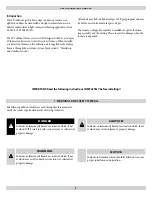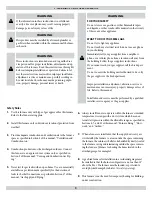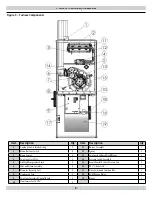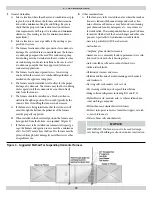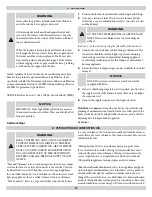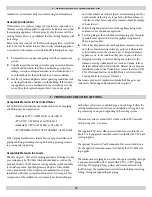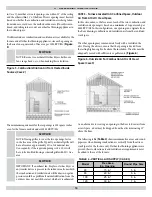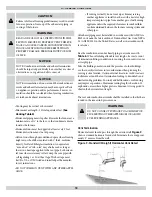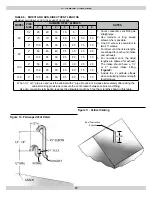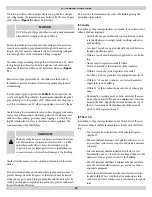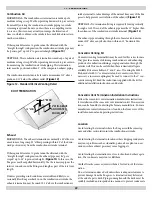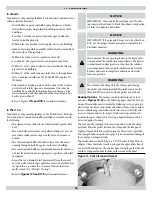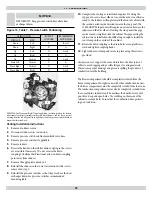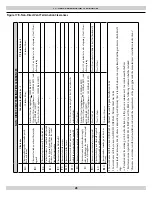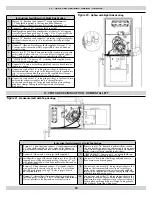
Th
e furnace, although designed as a direct vent type appliance, may
be installed with the intake vent inside the structure.
!
WARNING
THIS FURNACE AND ANY OTHER FUEL BURNING
APPLIANCE MUST BE PROVIDED WITH ENOUGH
FRESH AIR FOR PROPER COMBUSTION AND VEN-
TILATION OF THE FLUE GASES. MOST HOMES WILL
REQUIRE THAT OUTSIDE AIR BE BROUGHT TO THE
FURNACE AREA. FAILURE TO DO SO CAN CAUSE
PERSONAL INJURY, OR DEATH FROM CARBON
MONOXIDE POISONING.
Adequate provisions for combustion and ventilation air must be
in accordance with CAN/CGA-B149 in Canada, and ANSI Z223.1
- 1992, section 5.3, “Air for Combustion and Ventilation,” in the
United States. Check with local authorities for any additional build-
ing codes bylaws or regulations.
!
CAUTION
Air for combustion and ventilation purposes must not
originate from a corrosive atmosphere. Any furnace failure
caused by corrosive elements is excluded from warranty
coverage.
Th
e following types of installation sites (but not limited to the fol-
lowing) will REQUIRE OUTDOOR AIR for combustion because of
chemical exposures:
• Commercial buildings
• Buildings with indoor swimming pools
• Furnaces installed in laundry rooms
• Furnaces in hobby or craft rooms
• Furnaces installed near chemical storage areas
CASE 1 - Furnace Located In An Unconfi ned Space
Unconfi ned space does not necessarily mean that ventilation will
not have to be introduced from the outdoors, particularly in airtight
homes. Th
e minimum requirement for unconfi ned space is a volume
of 50 cubic feet for each 1000 BTU/Hr for all fuel burning appliances
located within the unconfi ned area.
If the amount of combustion and ventilation air is insuffi cient to
properly operate the furnace and other fuel burning appliances
within the unconfi ned area, it will be necessary to supply it from the
outdoors based on the criteria used when calculating the air supply
for a confi ned space.
Exposure to the following substances in the combustion air supply
(but not limited to the following) will also require OUTDOOR AIR
for combustion:
• Aerosols, particularly CFC based or propelled aerosols
• Air fresheners
• “Airplane Glue” and similar adhesives and cements
• Ammonia, as commonly found in permanent wave solu-
tions used in hair dressing salons
• Anti-static fabric soft eners used in clothes dryers
• Carbon tetrachloride
• Chlorinated cleaners and waxes
• Chlorine and bromine based swimming pool chemicals
• De-icing salts or chemicals (rock salt, etc.)
• Dry cleaning fl uids such as perchloroethylene
• Fumes from curing polyurethane and similar substances
• Halogen based refrigerants including R-12 and R-22
• Hydrochloric acid, muriatic acid and other acid based
masonry washing and curing materials
• Printer’s inks, paint removers, varnishes, varsol, toluene,
etc.
• Water soft ener salt and chemicals
Combustion air must be free of acid forming chemicals such as
sulphur, fl uorine and chlorine. Th
ese elements are found in aerosol
sprays, detergents, bleaches, cleaning solvents, air fresheners, paint
and varnish removers, refrigerants, and many other commercial and
household products. When burned in a gas fl ame, vapors from these
products form acid compounds. Acid compounds increase the dew
point temperature of the fl ue products and are highly corrosive aft er
they condense.
NOTICE
NOTE: If planning to use the inside air in an unconfi ned
space, remember to test for proper furnace operation (as
well as other fuel burning appliances located within the
unconfi ned space) with respect to adequate combustion
and ventilation air with fi replace dampers open, clothes
dryer running, bathroom exhaust fans on, kitchen range
hood on, etc.
CASE 2 - Furnace Located In A Confi ned Space
A confi ned space, (any space smaller than the minimums discussed
10 - NON-DIRECT VENT FURNACE INSTALLATIONS (USING INDOOR COMBUSTION AIR)
11 - DETERMINING COMBUSTION AIR
15



